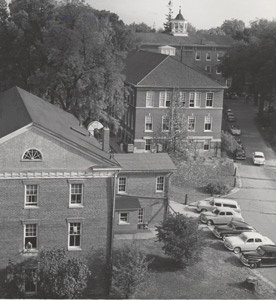Cars on campus
The automobile was no longer a novelty for Cornellians in 1926 when President Harlan Updegraff’s Buick sedan was stolen in Cedar Rapids (it was found in Iowa City). By 1930 the word jalopy had entered the language, and the following year all but a few miles of the Lincoln Highway, which passed along the north edge of the campus (now First Street West), had been widened and paved. It was only a matter of time before students’ cars and college policies collided.

One of the school’s first attempts at cruise control appeared in 1938–39: “Any student operating a car, even for a brief period, such as having the family car for the week-end, must meet these regulations [permission of a faculty committee] and must make application on forms which can be obtained at the office of the dean of men.”
World War II temporarily solved the college’s parking problem because gas and tires were rationed. The postwar years saw Americans moving to the suburbs; veterans, many married, enrolling under the G.I. Bill; and the beginning of the interstate highway system—all of which increased the number of automobile owners exponentially. The 1958–59 Student Handbooks prohibited freshmen from keeping a car anywhere near Mount Vernon during the academic year. Sophomores, juniors, and seniors were allowed to have cars if they were not receiving financial aid. The administration tried to oppose the inevitable even after passenger train service to Mount Vernon ended in 1961, in which year the college banned motorcycles and required upperclass students to have a cumulative GPA of C or higher (second semester freshman B) to keep a car at school. Eventually the administration recognized that the automobile was a necessity for many students and an important factor in recruitment and retention. Today the only requirements are that students register their cars, purchase a parking sticker, and park in designated areas.
Before World War II, The Cornellian reported that students were in the habit of driving to and from class and parking wherever they chose. The college continues today to set aside land for parking lots even though some students flout the rules and disdain the tickets they receive from campus safety officers. Others have avoided the registration fee by parking on city streets, much to the annoyance of the townspeople whose own spaces are usurped. Today many streets bordering campus offer only limited parking to non-residents.
One of the more bizarre parking incidents occurred when the Mount Vernon police responded to a call at 1:23 a.m. on March 18, 1981. Someone had reported a car with its front end sunk in Ink Pond and its rear on the grassy bank. The vehicle bore lettering indicating that it belonged to the University of Iowa. The unofficial explanation was that an inebriated Cornell student, abandoned by the friends who had driven him to Iowa City, needed a ride home and used his ingenuity.
